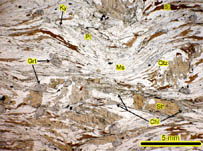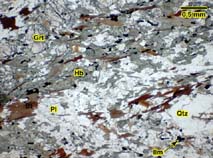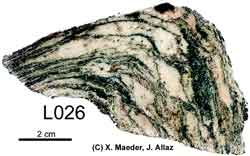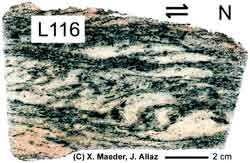Tectonic and metamorphic evolution of Simano nappe at Alpe Larecc (Tessin, CH) © 2003-2007, Uni. Lausanne (Switzerland).
Contacts: Xavier MAEDER (maederx@uni-mainz.de) or Julien ALLAZ (jallaz@geo.unibe.ch)
Page address... http://larecc.geoloweb.ch/fr/index.php?page=diplome_1 .......... Printed the 09.12.2025 at 05:47
| Back to entry | 1) Introduction | 2) Structural Study |
|
This diploma thesis focused on tectonic* and metamorphism* of the Alpe Larecc (Val Lavizzara, North of Ticino, Switzerland) around the main Lareccio anticline* (= Verzasca anticline), at the limit between pre-Mesozoic* metasediments* of the Campo Tencia unit and the Verzasca gneiss* complex on Simano nappe. Metasediments are mainly micaschists* (figure on the left) and paragneiss*. Besides both micas (biotite and muscovite), plagioclase (5-25% anorthite) and quartz (ubiquist in those lithologies), garnet, kyanite and staurolite are also often associated. In some particular lithologies*, garnet and/or staurolite can form centimetric porphyroblasts*. The metasediment layers with porphyroblasts are irregular from millimeter- to decameter-size thickness. The sediment are composed of an alternation of argilous (micas-rich) and detritics (rich in quartzo-feldspathic material) deposits. |

|

|
| Photographies of typical thin section of... | |
| Micaschist with Garnet + Staurolite + Kyanite | Amphibolite and paragneiss associated |
| Amphibolites* (in its broad sens, figure on the right) are composed of alternation of massive amphibolites (in the strict sens with often more than 75% amphibole) and paragneiss with amphibole (right figure). The amphibolite (strict sens) shows a mineral assemblage* with green hornblend (tschermakite), garnet, plagioclase (15-45% anorthite) and biotite. The local retromorphosis* of those rocks lead to the formation of epidote-calcite-chlorite assemblage. |
Finally, augen gneiss* (figure below) are formed of feldspars porphyroblasts (plagioclases [8-25% anorthite] and K-feldspars), quartz and two micas (muscovite and biotite). In the border, porphyroblasts tend to disappear, leaving place to a leucocratic* facies, called border facies (light rose in the geological map). This facies is formed by a top to the North shearing* linked to the nappes* emplacement (see next page). |

|

|
| Augen gneiss with quartz, plagioclases and potash feldspars | |
1) INTRODUCTION | 2) Structural | 3) Thermobarometry | 4) Tension gashes | 5) Cartography | Bibliography | Thanks
Aluminosilicate-bearing veines: 4.1) Mineralogy | 4.2) Structure | 4.3) Examples | 4.4) Formation
| Info on copyright || Download the abstract | the publication (PDF) |
This work is copyright protected (info under http://larecc.geoloweb.ch/eng/copyright.php).
Please, quote the authors and this work if you want to use the entire or a part of this web site. Thank you in advance!